
Władysław I Łokietek, in English known as the "Elbow-high" or Ladislaus the Short, was King of Poland from 1320 to 1333, and duke of several of the provinces and principalities in the preceding years. He was a member of the royal Piast dynasty, the son of Duke Casimir I of Kuyavia, and great-grandson of High-Duke Casimir II the Just.
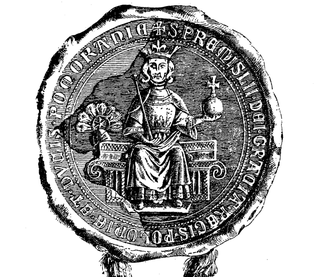
Przemysł II was the Duke of Poznań from 1257–1279, of Greater Poland from 1279 to 1296, of Kraków from 1290 to 1291, and Gdańsk Pomerania (Pomerelia) from 1294 to 1296, and then King of Poland from 1295 until his death. After a long period of Polish high dukes and two nominal kings, he was the first to obtain the hereditary title of king, and thus to return Poland to the rank of kingdom. A member of the Greater Poland branch of the House of Piast as the only son of Duke Przemysł I and the Silesian Princess Elisabeth, he was born posthumously; for this reason he was brought up at the court of his uncle Bolesław the Pious and received his own district to rule, the Duchy of Poznań in 1273. Six years later, after the death of his uncle, he also obtained the Duchy of Kalisz.

The Duchy of Greater Poland was a district principality in Greater Poland that was a fiefdom of the Kingdom of Poland. It was formed in 1138 from the territories of the Kingdom of Poland, following its fragmentation started by the testament of Bolesław III Wrymouth. In 1177, the state broke had separated into the duchies of Poznań, Gniezno and Kalisz, and united again in 1279, lasting in that form until 1320, when it was incorporated back into the Kingdom of Poland. Its capital was Poznań.

Przemysł I, a member of the Piast dynasty, was Duke of Greater Poland from 1239 until his death, from 1241 with his brother Bolesław the Pious as co-ruler. He was able to re-acquire large parts of Greater Poland, ruling as Duke of Poznań and Gniezno from 1247 and, upon several inheritance conflicts with his brother, as Duke of Poznań and Kalisz from 1249, sole Duke of Greater Poland from 1250, and Duke of Poznań from 1253 until his death.
This article covers the history of Poland in the Middle Ages. This time covers roughly a millennium, from the 5th century to the 16th century. It is commonly dated from the Fall of the Western Roman Empire, and contrasted with a later Early Modern Period. The time during which the rise of humanism in the Italian Renaissance and the Reformation unfolded is generally associated with the transition out of the Middle Ages, with European overseas expansion as a succeeding process, but such dates are approximate and based upon nuanced arguments.
Henry III of Głogów was a duke of Glogów from 1274 to his death and also duke of parts of Greater Poland during 1306–1310.
Odon of Poznań, also known as Odon of Greater Poland and Mieszkowic, was Duke of Greater Poland in 1179–1181, and Duke of Kalisz from 1193 to 1194.
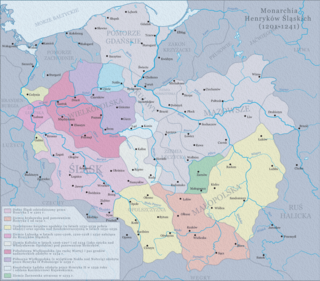
Seniorate Province, also known as the Senioral Province, was a district principality in the Duchy of Poland that was formed in 1138, following the fragmentation of the state. Its ruler held the title of the High Duke, ruling all duchies within Poland. In 1227, following the abolition of the High Duke title, the province was transformed into the Duchy of Kraków.
The district duchy, also known as the district principality, was a type of the state under the patrimonial system, such as duchy or principality, formed in the feudal system, as a result of land partition between the members of a royal family. It occurred in the Middle Ages and early modern period, notably in Europe, in states such as the Holy Roman Empire, Duchy of Poland, and Kievan Rus'.

Kazimierz III of Gniewkowo, was a Polish prince member of the House of Piast, Duke of Inowrocław during 1287-1314, since 1306 vassal of the Kingdom of Poland, Governor of the Duchy of Pomerelia during 1306-1309, after 1314 ruler over Gniewkowo.
Agnes of Poland was a member of the House of Piast and by marriage princess of Pereyaslavl and Volynia and grand princess of Kiev since 1168.

The period of rule by the Piast dynasty between the 10th and 14th centuries is the first major stage of the history of the Polish state. The dynasty was founded by a series of dukes listed by the chronicler Gall Anonymous in the early 12th century: Siemowit, Lestek and Siemomysł. It was Mieszko I, the son of Siemomysł, who is now considered the proper founder of the Polish state at about 960 AD. The ruling house then remained in power in the Polish lands until 1370. Mieszko converted to Christianity of the Western Latin Church in an event known as the Baptism of Poland in 966, which established a major cultural boundary in Europe based on religion. He also completed a unification of the Lechitic tribal lands that was fundamental to the existence of the new country of Poland.

The rule of the Jagiellonian dynasty in Poland between 1386 and 1572 spans the Late Middle Ages and the Early Modern Period in European history. The Lithuanian Grand Duke Jogaila founded the dynasty; his marriage to Queen Jadwiga of Poland in 1386 strengthened an ongoing Polish–Lithuanian union. The partnership brought vast territories controlled by the Grand Duchy of Lithuania into Poland's sphere of influence and proved beneficial for both the Polish and Lithuanian people, who coexisted and cooperated in one of the largest political entities in Europe for the next four centuries.
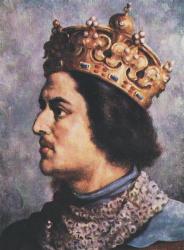
The Treaty of Kępno was an agreement between the High Duke of Poland and Wielkopolska Przemysł II and the Duke of Pomerania Mestwin II signed on February 15, 1282, which transferred the suzerainty over Gdańsk Pomerania (Pomeralia) to Przemysł. As a result of the treaty Przemysł adopted the title dux Polonie et Pomeranie.

The Duchy of Płock was a feudal district duchy in Masovia, centered on the Płock Land. Its capital was Płock. It existed in the High Middle Ages era, from 1275 to 1294, from 1310 to 1351, and from 1381 to 1462.
Casimir II of Łęczyca was a Polish prince member of the House of Piast, Duke of Brześć Kujawski during 1267–1288, Duke of Dobrzyń during 1275–1288 and Duke of Łęczyca since 1288 until his death.
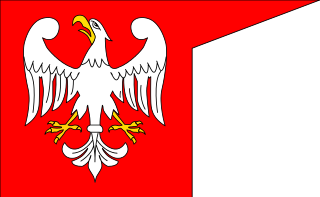
The Duchy of Poznań was a feudal district duchy in the Greater Poland, centered on the Poznań Land. Its capital was Poznań. The state was established in 1177, in the partition of the Duchy of Greater Poland, after the rebellion against Mieszko III. Duke Odon of the Piast dynasty become its first ruler. It existed until 1279, when, it got united with duchies of Gniezno and Kalisz, under the rule of Przemysł II, forming the Duchy of Greater Poland. It remained a fiefdom within the Duchy of Poland, until 1227, and after that, it become an independent state.
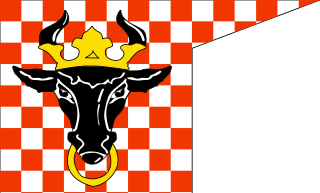
The Duchy of Gniezno was a feudal district duchy in the Greater Poland, centered on the Kalisz Region. Its capital was Gniezno. The state was established in 1177, in the partition of the Duchy of Greater Poland, after the rebellion against Mieszko III. Duke Casimir II the Just of the Piast dynasty become its first ruler. It existed until 1279, when, it got united with duchies of Kalisz and Poznań, under the rule of Przemysł II, forming the Duchy of Greater Poland. It remained a fiefdom within the Duchy of Poland, until 1227, and after that, it become an independent state.
The civil war in Pomerelia was a military conflict in Pomerelia fought from 1269 to 1272. The conflict began between members of the Samboride dynasty, with Mestwin II, ruler of the Duchy of Świecie fighting against Wartislaw II of Gdańsk, ruler of the Duchy of Gdańsk, and Sambor II, ruler of the Duchy of Lubiszewo. In 1270, Mestwin had conquered their states, unifying the Duchy of Pomerelia under his rule. Wartislaw II and Sambor II continued to fight from exile, aided by the Duchy of Inowrocław and the State of the Teutonic Order, while Mestwin had allied with Bolesław the Pious, ruler of the Duchy of Greater Poland. In 1271, the war was joined by the Margraviate of Brandenburg who attempted to conquer the Duchy of Pomerelia. The war ended in January 1272, with Mestwin II's victory, establishment of the Duchy of Pomerelia, and partition of the Duchy of Inowrocław between Pomerelia and Greater Poland.
The War for Brest was Prince Casimir II the Just's military campaign against Kievan Rus following the fall of Brest. Casimir quickly captured the city and made efforts to restore Prince Mstislav to the throne of Halych. Despite initial reluctance from some Polish lords, Casimir led his forces into battle against opposing Rus princes. The engagement culminated in a decisive victory for Casimir, resulting in the surrender of Ruthenians and the restoration of Mstislav to the throne.














